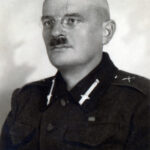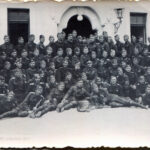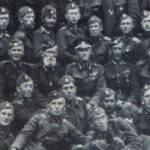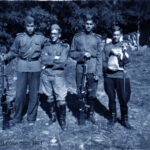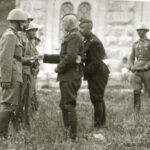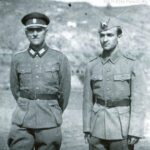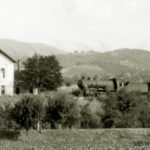- Russian Protective Corps Guide books, WW2 battlefield maps and virtual tour
Uniform. Initially, the uniform of the Corps was similar to our Russian Army uniform from the First World War. In a single-breasted military Yugoslav uniform of a khaki color, the standing collar was remade into a turn-down one and overcoat buttonholes were sewn on it. On the shoulders of the same protective cloth were sewn old Russian epaulettes, denoting the last rank in the Russian army, which had no official significance. The ranks and ranks of positions held in the Corps were marked on buttonholes, like the Red Army. The lieutenant had a narrow silver strip on his buttonhole, the chief lieutenant had one, and the hauptmann had two square stars. Major – two silver stripes, Oberst Lieutenant – with one, and Oberst – with two stars. The general had a gold stripe, a red general’s stripe and an overcoat with a red lining.
The ranks of the remaining ranks were indicated by the corresponding number of corners from the same silver braid, sewn on the sleeve, above the elbow.
Headgear: garrison cap, Russian-style cap and helmet with a white militia cross.
Lacking this uniform, the newly formed units were dressed in dark brown uniforms built by their own care. With the transition to the Wehrmacht, the Corps was dressed in new German uniforms and all Russian distinctions were abolished. The color of the type of weapon: light green (sanitary personnel – cornflower blue, and veterinary – crimson). (by B. Yankovsky)
- Uniform 1942, shoulder straps of an artillery colonel (WWI) and oberleutnant’s buttonholes (Russian Corps), L1
- “8th Artillery Hundred in Mitrovica” (? 1942, B81)
- Hundred commander and officers, fragment 81
- “Belgrade 1941”, cadets with machine guns and a dog (B61)
- First promotion to officer rank, Ljubovija, BB13bd
- Orthodox icon and priest, BB13vd
- Hybrid uniform – German tunic, Russian cap and belt, B34d
- Summer sports uniform, shorts and T-shirt, B32d
B32d A wonderful photograph showing the summer sports uniform of the ranks of the Russian Protective Corps in 1942 and 1943. Briefs, a sports jersey and a T-shirt, but with a Serbian type death identification tag (ID token). A small pocket is clearly visible on the pants, possibly for this token. Jošanička Banja Serbian resort, 8th artillery hundred of the 3rd regiment.
N B34d An example of a hybrid uniform: a German officer’s and soldier’s tunic and shoulder straps, a Russian cap (“furazhka”) and “pilot cap” (“pilotka”). The German eagle on the chest is missing, but there is a Russian cockade from the First World War. The belt is Russian or Czech. Commander of the 8th artillery hundred of the 3rd regiment, Colonel Murzi and son, Jošanička Banja resort, 1943 (?).
Russian Protective Corps Weapons
Weapons, the small arms, machine guns and artillery, as well as transport, the bicycles, the cars, the trucks and the horses.
The military units of the Russian Corps were equipped with the following types of weapons:
Rifle companies: 1) Yugoslav (“Mauser”) and Italian rifles.
2) Light machine guns “Zbroevka”, “Shosha” and Italian.
3) Light bombers (mortars).
4) Hand grenades of different systems: German, Serbian and Italian.
Platoons of heavy weapons: 1) 4 heavy machine guns “Maxim”, “Schwarzlose”, “Vickers” and Italian.
2) 4 heavy grenade launchers (mortar, bomb launcher) 8 cm. Skoda and Italian.
Artillery platoons of the 1st, 2nd and 3rd regiments – 2 Serbian field guns 75 mm Schneider system each.
4th and 5th regiments – 2 Italian mountain guns each.
PAK platoons. 2 or 3 guns 37 mm “Skoda”.
Revolvers and pistols. Initially, they were delivered independently by personal initiative, there were a variety of systems and were available mainly only to officers. In 1944, state-owned “Steyer” appeared for non-commissioned officers and lighter Italian ones for officers.
Light machine guns. State-issued were first issued in the autumn of 1944 (German MPs) in very small numbers. Their number gradually grew due to trophies.
During the formation of the 1st regiment, we received Mauser rifles and Zbroevka light machine guns (Czechoslovakia), of very high quality.
Memoirs of veterans from the archives of the Russian Corps.
How did the Germans arm us? With the transfer of the 1st battalion to the 2nd regiment, the Zbroevka machine guns were replaced by the Shosh machine gun. It was not necessary to meet a more unsuccessful machine gun – it was heavy, uncomfortable, had strong recoil, poor shooting accuracy and was very capricious – “I want – I shoot, I want – no.” After our troubles, this machine gun was replaced by an Italian one, of good quality. When the 4th regiment began to form, Italian carbines of very poor quality were received for service with this regiment. They were short, with a screwed bayonet, light and simple in design, but their combat was only 500 paces. In addition, the accuracy of the battle was such that in order to hit the target, it was necessary to aim two or three meters below it. In the middle of 1944 they received longer Italian rifles, but also of poor quality, and therefore they were soon replaced by the Mauser.
Only one pistol per company was received for launching rockets, and there were not a single machine gun. Already at the end of 1944, they managed to take away the Soviet machine gun “Degtyarev” and one German one from the partisans. Light bombers were very good – they are easy to carry and with accurate combat. (by Nevzorov A.)
Cars, trucks, armored carriers and tanks in the Russian Corps
Author’s addition* to the 1963 edition. According to a study of photographs, when conducting anti-partisan raids of the Russian Corps together with German units, old captured French tanks such as Renault and Hotchkiss were used after the 1940 campaign in France. To transport parts and cargo by rail, homemade armored trains with tanks or machine-gun turrets mounted on platforms have been discovered. Research is ongoing and the authors would appreciate any additional information.
Steam locomotives, carriages, armored trains in the Russian Corps
The Russian Protective Corps did not have its own railway equipment, but constantly used the provided railway vehicles for travel. It is known for sure that at the end of the WW2, on the battlefields in Serbia, the Russian Protective Cprps acted against Tito’s partisans and the Red Army together with a German armored train.
- Steam locomotive and carriages at the Jošanička Banja station, B36d
B36d photo of Jošanička Banja mud bath resort, 1942 or 1943. Steam locomotive and carriages near the Jošanička Banja railway station.

